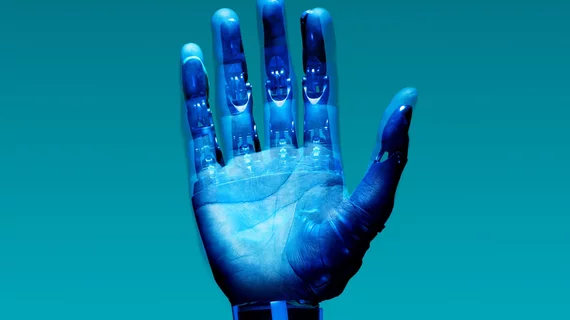While big breakthroughs in healthcare AI seem to have slowed in recent weeks, those involving other hot technologies have kept the content coming for publishers of peer-reviewed medical journals.
Here are three such innovations that caught our eye in recent weeks.
1. A wearable strain sensor that functions like “electronic skin” to monitor joint motion and breathing cycles. Researchers at the University of Colorado Boulder and colleagues in China developed this device to stretch with movement and heal itself with liquid metal when it gets slightly damaged. If the “injury” is worse, the unit can be reconfigured to move from monitoring just about any joint to the abdomen for respiratory duties—or vice versa. It’s made with off-the-shelf chip components and, at the end of its life cycle, it can be recycled at room temperature.
Study describing the development published in Research July 29. Chuanqian Shi, Jianliang Xiao, et al.:
When integrated with a light-emitting diode (LED), this device can provide real-time warning of excessive joint motions during training or other physical activities. Unlike a conventional rotary encoder strain sensor, such wearable devices are beneficial for health monitoring due to their soft and stretchable characteristics. … [The device] provides a reliable, economical, and ecofriendly solution to wearable technologies.”
2. 3D bioprinted multicellular blood vessels that replicate properties of cardiovascular disease. Researchers at Texas A&M University are after a better understanding of complex problems with vascular function (as distinct from structural vascular defects). Their primary goal is to help revive cardiological drug development, which they suggest has lately gone lackluster.
Study published in Advanced Healthcare Materials July 26 and covered by the university’s news office Aug. 16. Karli Gold, Akhilesh Gaharwar, et al.:
A remarkably unique characteristic of this bioink is that, regardless of cell density, it demonstrates a high printability and ability to protect encapsulated cells against high shear forces in the bioprinting process. … [This] 3D bioprinted vessel is able to [mimic] thromboinflammatory responses observed only in advanced in vitro preclinical models or in vivo. Therefore, this 3D bioprinted vessel provides a potential tool to understand vascular disease pathophysiology and assess therapeutics, toxins or other chemicals.”
3. A prosthetic hand that supplies the wearer with both tactile feedback and control of electric signals generated by muscle tissue. A team at MIT is behind this step forward in prosthetic design, the product of which the developers say is softer, lighter and more affordable than the current state of the art in artificial hands.
Study published in Nature Biomedical Engineering and covered by MIT News Aug. 16. Guoying Gu, Xuanhe Zhao, et al.:
In a set of standardized tests performed by two individuals with transradial amputations, we show that the soft neuroprosthetic hand outperforms a conventional rigid neuroprosthetic hand in speed and dexterity. We also show that one individual with a transradial amputation wearing the soft neuroprosthetic hand can regain primitive touch sensation and real-time closed-loop control.”

